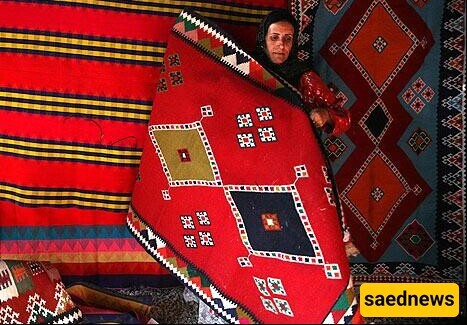The art of Verni weaving, also known as needlepoint carpet weaving, is crafted by nomadic women. Stay with Saeed News to learn more about this art.

In the Arasbaran region of Azerbaijan, rugs are woven that fall between carpets and kilims in terms of texture, design, and pattern. These woven pieces combine the style of kilim with the delicacy of a carpet. Like kilim weaving, Verni (or Soumak) weaving does not use knots; instead, the interlacing of warp and weft creates the designs. Verni weaving is based on the technique of weft wrapping, where the main weft passes through the warp, and the thread is twisted around the warp threads, forming the pattern. Due to the use of a pile knot in its weaving, Verni is considered a type of kilim, but in terms of design, pattern, and appearance, it is similar to a carpet.
What is Verni?
Verni, also known as Soumak, is a handwoven textile that falls between kilim and carpet weaving techniques. It is woven on a vertical or horizontal loom like a kilim or carpet, and features a thick weft. It is one of the most iconic handicrafts of East Azerbaijan, widely woven by nomadic women in the Ahar and Arasbaran regions. Verni, while maintaining the simplicity and lightness of a kilim, also possesses the unique artistic delicacy of a carpet. Due to the use of pile knots in its weaving, it is considered a type of kilim but, in terms of design, pattern, and appearance, it closely resembles a carpet. Verni is a single-layered kilim, and its weaving style lies between kilim and carpet weaving. The art of Verni weaving is native to Azerbaijan and continues to thrive and attract demand. It is primarily woven by women and girls in the winter quarters of nomadic tribes, where work volume is lower. As a result, the designs and colors of Verni reflect the culture, beliefs, and spirit of nomadic life.



History of Verni Weaving
Verni weaving is one of Iran's traditional handicrafts. Verni, as a type of mat, rug, or household item, originated and developed primarily in the migratory and settled regions of the Shahsavan nomads in the northeastern Azerbaijan area and some surrounding regions. Since the history, culture, and literature of the nomads have traditionally been passed down orally and through generations, much of the historical records about the origins and spread of Verni weaving in Azerbaijan have been lost over time. However, the discovery of old Verni pieces from the Qajar period and even earlier suggests a historical tradition of over 200 years of Verni weaving in Iran.
Verni Patterns
The patterns used in traditional handwoven textiles often reflect the surroundings of the weaver or their beliefs and dreams (or what they seek from their deity). The general design of Verni consists of three parts: the border, the field, and the central motif (teranj). A key decorative feature in Verni designs is the "S" element, which sometimes appears in the form of an "S" or "5." In nomadic culture, this element represents a dragon. Weavers use patterns such as deer, gazelle, wolves, herding dogs, turkeys, chickens, jackals, foxes, local birds, and more, beautifully and geometrically arranged.



Verni Weaving Technique
Weaving Method (Wefting): In this method, only warp (chileh) and weft yarns are used for weaving. The colorful wefts pass over and under the warp threads, and through changes in the weft colors, the designs emerge. Both sides of the fabric become smooth, flat, and uniformly colored.
Weft Wrapping Technique: This method uses both warp and weft yarns, along with a thin additional weft, which twists through the warp threads. By passing the thin weft through and pressing it with a comb, the intertwining of the warp and weft is finalized. This technique, often considered an intermediate stage between kilim and carpet weaving, represents the final step in the evolution of kilim weaving into carpet weaving. This method is used in weaving Verni kilims in East Azerbaijan and "Shiriki Pich" kilims in Kerman province. These kilims, woven using the weft-wrapping technique, are referred to as Soumak. Sometimes, needlework is applied to these kilims, leading to their fame as "Needlework Kilims."
Final Thoughts
The primary production area for Verni is the Karabakh region, particularly the city of Shamakhi. Due to cultural and tribal relations and the movements along the banks of the Aras River, Verni production gradually spread to the Arasbaran region and, later, among the tribes and nomads of the Mugan Plain. Today, more than 20,000 people in the region, especially in Ahar, are engaged in Verni production, supporting their livelihoods through this craft.

